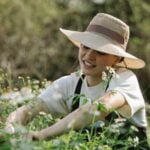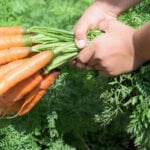Flower and vegetable gardens offer a delightful combination of beauty and abundance. There is something truly enchanting about the sight of vibrant blooms and lush greenery, alongside a bounty of fresh vegetables.
In recent years, gardening has seen a tremendous surge in popularity, as more and more people recognize the benefits of cultivating their own little slices of paradise. Whether you have a sprawling backyard or a cozy balcony, there are endless possibilities for creating your very own flower and vegetable gardens.
Gardening has become not only a fulfilling hobby but also a growing trend. With an increasing focus on sustainability and self-sufficiency, individuals are turning to gardening as a way to reconnect with nature and nurture their well-being. The allure lies in the ability to grow your favorite flowers for their aesthetic appeal while also reaping the rewards of cultivating your own delicious produce.
When it comes to flower gardens, there are countless styles, themes, and color schemes to choose from. You can create romantic cottage gardens bursting with roses and perennials or opt for sleek modern designs featuring sculptural plants and ornamental grasses. The key is to carefully plan and design your flower garden so that it showcases your personal taste while also considering factors such as bloom times and maintenance requirements.
Vegetable gardens, on the other hand, offer an opportunity to savor homegrown goodness while saving money at the grocery store. Imagine stepping outside to pick plump tomatoes for a salad or harvesting fresh herbs for an aromatic pasta sauce – it’s both rewarding and economical. Understanding crop rotation, companion planting, as well as selecting vegetables that thrive in your specific climate and soil conditions are crucial for ensuring bountiful yields.
In this article, we will explore the ins and outs of creating beautiful flower gardens that awaken the senses as well as nurturing vegetable gardens that provide nourishment for our bodies. From choosing the right location to maintaining these bountiful spaces throughout the seasons, we will provide you with expert tips and guidance.
So whether you are a seasoned gardener or a beginner taking your first steps into the world of horticulture, let us embark on this gardening journey together and revel in the beauty and bounty of flower and vegetable gardens.
Choosing the Right Location
When it comes to creating flower and vegetable gardens, selecting the right location is crucial for their success. The chosen spot will serve as the backdrop for your gardens, providing the necessary elements for plants to thrive. In this section, we will explore the importance of choosing an ideal location and discuss the factors to consider.
Importance of Selecting the Ideal Spot
The location of your gardens can greatly impact their growth and productivity. Both flowers and vegetables require sunlight to photosynthesize and grow, so it is essential to choose a spot that receives ample sunlight throughout the day. Additionally, consider the soil condition in your chosen area. Conduct a soil test to determine its pH levels and nutrient composition. This will help you understand if any amendments are required before planting.
Accessibility is another important factor to consider when choosing a location. Ensure that your gardens are easily accessible for maintenance tasks such as watering, pruning, and harvesting. You may want to have your garden close to a water source or consider installing irrigation systems for convenience.
Tips on Assessing and Preparing the Chosen Area
Before you start planting, take some time to assess and prepare your chosen area for gardening success. Start by clearing any existing vegetation or debris from the plot to create a clean canvas for your gardens. Once cleared, amend the soil based on the results of your soil test. This may involve adding compost or organic matter to improve soil fertility.
Consider installing edging or borders around your gardens to define their boundaries and prevent encroachment from nearby plants or grasses. This will also add structure and visual appeal to your overall garden design.
Lastly, ensure proper drainage in your gardens by amending or modifying the soil if necessary. Poor drainage can lead to root rot or other issues that compromise plant health.
By carefully selecting a suitable location and preparing it properly, you are setting the stage for a successful flower and vegetable garden. Remember to regularly assess your gardens’ needs to ensure they continue to thrive in their chosen location.
Planning and Designing Your Flower Garden
Creating a beautiful and well-designed flower garden requires careful planning and consideration. A well-thought-out plan will ensure that your flower garden not only looks stunning but also thrives with minimal maintenance. Here are some tips and suggestions to help you in planning and designing your flower garden.
First, consider the style and theme you want for your garden. There are various styles to choose from, such as a formal garden with structured beds and hedges, or a cottage garden with an abundance of colorful flowers. Think about the overall mood and ambiance you want to create in your garden, whether it is peaceful and serene or vibrant and lively.
Color scheme is also an important aspect of flower garden design. Consider using a color wheel to guide your selection of flowers. You can choose complementary colors for a harmonious look or opt for contrasting colors for a more dramatic effect. Additionally, think about the bloom times of different flowers to ensure that you have continuous blooms throughout the growing season.
When selecting flowers for your garden, consider their maintenance requirements. Some flowers require more care than others, so choose varieties that align with the amount of time you’re willing to invest in maintaining them. It’s also a good idea to select flowers that are well-suited for your climate and growing conditions.
| Climate | Popular Flower Choices |
|---|---|
| Mediterranean | Bougainvillea, Geraniums, Lavender |
| Tropical | Hibiscus, Orchids, Bird of Paradise |
| Temperate | Roses, Daisies, Tulips |
| Arctic | Anemones, Forget-Me-Nots, Poppies |
By considering these factors and incorporating them into your flower garden plan, you’ll be well on your way to creating a stunning and vibrant outdoor space that brings joy and beauty to your surroundings. Remember to have fun with the process and let your creativity shine through.
Nurturing a Bountiful Vegetable Garden
As more people embrace sustainability and self-sufficiency, the popularity of vegetable gardens has surged. Growing your own vegetables not only ensures freshness but also provides cost savings and the satisfaction of harvesting your own food. However, to have a bountiful vegetable garden, careful planning and nurturing are essential.
One key aspect of successful vegetable gardening is proper planning. This involves considering factors such as crop rotation and companion planting. Crop rotation helps prevent nutrient depletion in the soil and reduces pest and disease problems. By rotating crops, you can also improve soil fertility and plant health. Companion planting involves strategically growing different plants together to maximize productivity or deter pests. For example, planting marigolds alongside tomatoes can help repel insects that may harm the tomato plants.
Another crucial aspect of nurturing a bountiful vegetable garden is selecting the right vegetables for your climate and soil conditions. Some vegetables thrive in cool temperatures while others prefer warm climates. Additionally, certain crops require specific soil pH levels or moisture levels to grow well. By understanding your climate and soil characteristics, you can choose vegetables that are well-suited for your garden’s conditions, which will ultimately increase your chances of success.
| Vegetable | Preferred Climate | Soil Type |
|---|---|---|
| Tomatoes | Warm to hot climates | Well-draining, fertile soil |
| Lettuce | Cooler climates or partial shade in warmer climates | Moist but well-drained soil rich in organic matter |
| Carrots | Cool to warm climates | Sandy or loamy, well-draining soil without stones |
By selecting vegetables that align with your specific climate and soil conditions, you can increase the likelihood of a successful and bountiful vegetable garden. Additionally, understanding crop rotation and companion planting techniques will further enhance the productivity and health of your garden. With proper planning and nurturing, you’ll be well on your way to enjoying the fruits (or in this case, vegetables) of your labor.
Essential Tools and Equipment for Flower and Vegetable Gardens
When it comes to maintaining a thriving flower and vegetable garden, having the right tools and equipment is essential. Here are some must-have items that will help you keep your gardens in top shape:
- Garden Gloves: Protect your hands from thorns, insects, and dirt with a sturdy pair of gardening gloves. Look for gloves that provide both comfort and dexterity.
- Trowel: A trowel is a small, handheld tool that is perfect for digging holes and transplanting seedlings. Choose one made of stainless steel or carbon steel for durability.
- Pruning Shears: Pruning shears are vital for maintaining the health and shape of your plants. Opt for ones with sharp blades and ergonomic handles.
- Watering Can or Hose: To ensure proper hydration for your plants, invest in a watering can or hose with an adjustable nozzle. Watering cans are ideal for smaller gardens, while hoses are more suitable for larger areas.
In addition to these basic tools, there are also some optional but highly useful equipment that can enhance your gardening experience:
- Raised Beds: Raised beds offer several advantages, including improved drainage, better control over soil quality, and reduced strain on your back. Consider building or purchasing raised beds if you have limited space or poor soil conditions.
- Trellises or Stakes: If you are growing climbing plants like tomatoes or beans, trellises or stakes will provide support and keep them off the ground. This helps maximize sunlight exposure and prevents diseases caused by soil contact.
- Kneeling Pad: Gardening can be hard on the knees, so investing in a comfortable kneeling pad can save you from discomfort. Look for a pad with thick cushioning that offers both support and protection.
To ensure the longevity of your tools and equipment, proper maintenance is essential:
- Clean tools after each use to prevent the spread of diseases.
- Keep blades sharp and lubricated to ensure smooth cutting.
- Store tools in a dry place to prevent rusting.
- Check handles periodically for cracks or splinters, replacing them if necessary.
By having these essential tools and equipment and taking care of them properly, you will be well-equipped to create and maintain stunning flower and vegetable gardens. So, gather your gardening gear and get ready to enjoy the fruitful rewards of your labor.
Maintaining Your Gardens
Once you have established your flower and vegetable gardens, it is crucial to maintain them properly to ensure their health, beauty, and productivity. This section will provide you with essential tips and techniques for watering, pruning, and controlling weeds in your gardens.
Watering is a vital aspect of maintaining your gardens. It is important to water your plants consistently and appropriately to avoid under or over-watering. One key tip is to water deeply but less frequently to encourage deeper root growth and prevent surface evaporation. Monitor the moisture levels in the soil regularly and adjust your watering schedule accordingly. In addition, try to water early in the morning or late in the evening when the temperature is cooler to minimize evaporation.
Pruning plays a crucial role in promoting healthy growth and enhancing the aesthetics of your flower garden. Regular pruning helps remove dead or diseased branches, encourages new growth, and shapes the plants. When pruning flowers, it’s essential to know their specific requirements since different types of flowers may require different approaches. For example, some flowers benefit from deadheading (removing spent blooms) while others may need selective pruning for size control.
Weed control is another vital aspect of maintaining both flower and vegetable gardens. Weeds compete with your plants for nutrients, sunlight, and water; therefore, it’s important to address them promptly. One effective method is hand-weeding – manually removing weeds by pulling them out from the roots. Mulching can also help suppress weed growth by smothering them underneath a layer of organic material. Be cautious when using herbicides as they can harm desirable plants if used incorrectly or excessively.
By following these maintenance practices for watering, pruning, and weed control, you’ll be able to keep your flower and vegetable gardens thriving throughout the growing season. Proper maintenance not only ensures healthy plant growth but also enhances the overall visual appeal of your gardens. The next section will delve into common pests and diseases that may affect your gardens, and how to deal with them effectively.
Dealing with Common Pests and Diseases in Flower and Vegetable Gardens
Identifying Common Pests and Diseases
In order to effectively deal with pests and diseases in your flower and vegetable gardens, it is crucial to be able to identify the specific issues that may arise. Some common pests that can wreak havoc on both flower and vegetable plants include aphids, caterpillars, slugs, snails, and beetles. These pests can cause damage by feeding on leaves, stems, or fruits, resulting in stunted growth or even death of the plants.
Similarly, diseases such as fungal infections (e.g., powdery mildew or blight) and viral infections (e.g., mosaic virus) can lead to discoloration, wilting, or decay of plant tissues. Being able to identify these pests and diseases early on will allow you to take prompt action and prevent them from spreading further.
Organic Pest Control Methods
Many gardeners prefer using organic methods to control pests and diseases in their gardens due to their environmental friendliness and minimal impact on beneficial insects. One effective organic pest control method is companion planting. By interplanting certain flowers or herbs among your vegetables and flowers, you can deter pests naturally.
For example, marigolds are known for repelling nematodes when planted near tomatoes. Additionally, introducing beneficial insects such as ladybugs or lacewings into your garden can help keep pest populations under control.
When faced with fungal or viral infections, it is important to practice good hygiene in the garden. This includes removing infected plant parts promptly to prevent the spread of spores or viruses. You can also use natural fungicides like neem oil or baking soda spray to combat fungal infections. Another organic approach is applying compost tea or other organic fertilizers regularly to strengthen plant immune systems.
Early Detection and Prevention
Early detection is key in effectively managing pests and diseases in your flower and vegetable gardens. Regularly inspect your plants for any signs of damage, discoloration, or unusual growth. By catching problems early on, you can take immediate action, preventing them from becoming widespread issues. In addition, practicing good gardening techniques such as providing adequate spacing between plants and maintaining proper watering habits can help prevent the conditions that favor the development of pests and diseases.
Remember that prevention is always better than cure when it comes to pest and disease management. Implementing simple preventive measures such as rotating your crops each year and avoiding overcrowding in the garden can reduce the likelihood of recurring problems. It is also helpful to research specific pests or diseases common to your region so that you can take preemptive measures to protect your plants.
By being vigilant, employing organic pest control methods, and practicing early detection and prevention, you can minimize the impact of pests and diseases on your flower and vegetable gardens while ensuring healthy plant growth and abundant harvests.
Harvesting and Enjoying the Fruits of Your Labor
One of the most rewarding aspects of having flower and vegetable gardens is reaping the benefits of your hard work. Harvesting the fresh produce from your vegetable garden or picking beautiful blooms from your flower garden can bring a sense of accomplishment and joy. In this section, we will explore the process of harvesting and offer suggestions on how to make the most of your garden’s bounty.
Proper Harvesting Techniques
When it comes to harvesting flowers, timing is key. Different types of flowers have different maturity stages at which they are best for cutting. To ensure long-lasting blooms, it’s important to harvest flowers at their peak freshness. Here are a few guidelines:
- Cut flowers in the early morning or late evening when they are adequately hydrated.
- Use sharp shears or pruners to make clean cuts just above a node or bud.
- Remove any foliage below the water line to prevent bacterial growth.
- Place cut flowers immediately into a bucket of water to prolong their vase life.
When it comes to vegetable gardens, knowing when to harvest is crucial for optimal flavor and texture. Here are some general tips for harvesting common vegetables:
- Tomatoes: Harvest tomatoes when they have reached their mature color but are still slightly firm, as they will continue ripening off the vine.
- Leafy Greens: Pick leafy greens such as lettuce and kale by removing outer leaves as needed, allowing inner leaves to continue growing.
- Root Vegetables: Carefully dig out root vegetables like carrots and beets, checking for adequate size before harvesting.
- Herbs: Snip herbs just above a leaf node to encourage further growth throughout the season.
Creative Ways to Enjoy Your Garden’s Produce
Once you have harvested your flowers and vegetables, it’s time to enjoy them. Here are some creative ideas for making the most of your garden’s bounty:
- Flower Arrangements: Use your freshly cut flowers to create stunning floral arrangements for your home or give as thoughtful gifts.
- Culinary Delights: Incorporate your homegrown vegetables into delicious recipes, such as a garden-fresh salad, vegetable stir-fry, or homemade salsa.
- Preserving the Harvest: Extend the life of your produce by preserving them. Consider canning or freezing fruits and vegetables to enjoy their flavors throughout the year.
- Sharing with Others: Spread the joy of your garden by sharing extra produce with neighbors, friends, or local food banks.
Remember, the true pleasure of having flower and vegetable gardens lies in not just growing them but also enjoying the benefits they bring. Whether you’re admiring vibrant blooms or savoring a home-cooked meal made from your own harvest, these gardens truly offer a feast for the senses. So go ahead and relish in the fruits of your labor.
Conclusion
In conclusion, flower and vegetable gardens offer a multitude of benefits and bring both beauty and bounty to our lives. The rising popularity of gardening reflects a growing interest in connecting with nature, enjoying fresh produce, and creating stunning outdoor spaces. With careful planning, proper maintenance, and a little bit of knowledge, anyone can create their own flourishing gardens.
Choosing the right location is crucial for the success of both flower and vegetable gardens. Assessing factors such as sunlight, soil condition, and accessibility will ensure that plants thrive in their environment. Additionally, taking the time to plan and design your flower garden will result in a visually appealing space that suits your personal style. From selecting the right flowers to considering bloom times and maintenance requirements, thoughtful choices lead to stunning results.
For those interested in cultivating their own vegetables at home, the benefits are plentiful. In addition to enjoying freshness and cost savings, growing your own produce allows you to have control over what goes into your food. By following essential vegetable garden techniques such as crop rotation and companion planting, you can maximize productivity and prevent diseases.
To maintain both flower and vegetable gardens successfully, it is essential to have the right tools on hand. Basic gardening tools are necessary for day-to-day maintenance tasks such as watering, pruning, and weed control. Optional equipment like raised beds or trellises can make gardening easier while proper storage ensures the longevity of these tools.
Although pests and diseases can pose challenges to our gardens, there are organic solutions available that are safe for humans and beneficial insects. Early detection paired with prompt action is crucial for protecting plants from serious damage. By practicing good pest control strategies alongside proper cultivation techniques,.
Finally, harvesting the fruits – or in this case flowers – of our labor is one of the most rewarding aspects of gardening. There is great satisfaction in plucking beautiful blooms or gathering fresh vegetables straight from our own backyard. Whether enjoyed on their own or used creatively in recipes shared with family and friends, the produce from our gardens brings us closer to nature and nourishes both body and soul.
Frequently Asked Questions
Can you have a flower and vegetable garden together?
Yes, it is possible to have a flower and vegetable garden together. In fact, combining these two types of plants can provide a range of benefits. Flowers can attract pollinators like bees and butterflies, which are essential for the fertilization of many vegetables. Additionally, certain flowers can help repel pests that may damage your vegetables, making them a natural pest control option.
However, there are a few considerations when planting both together. For instance, choosing flowers that will not overshadow the vegetables is important to ensure they all receive adequate sunlight. It may also be necessary to separate some flowering plants from vegetables due to their differing water or soil requirements.
What flowers and vegetables grow well together?
Several flowers and vegetables grow well together and can even enhance each other’s growth and overall health in what is often referred to as companion planting. Marigolds are an excellent example of flowers that do well alongside many vegetables including tomatoes, peppers, and cucumbers. These colorful blooms deter harmful insects through their scent, reducing the need for pesticides.
Nasturtiums are another beneficial flower that thrives alongside various vegetables such as beans, cabbage, and squash. They attract aphids away from the more vulnerable veggies while adding vibrant color to the garden.
What flowers should not be planted near vegetables?
While there are numerous flowers that complement vegetable growth through companion planting techniques, certain ones should be kept away from vegetables as they could hinder their development or attract unwanted pests or diseases. For instance, coneflowers (Echinacea) should not be planted near beans or cucumbers because they have been known to stunt their growth.
Another example is sunflowers, which can cast too much shade on neighboring plants if not positioned appropriately within the garden layout. Additionally, roses should be planted separately from tomatoes as they can attract similar pests such as aphids or spider mites that could harm the tomato plants.

If you’re looking to get into vegetable gardening, or are just looking for some tips on how to make your current garden better, then you’ve come to the right place! My name is Ethel and I have been gardening for years. In this blog, I’m going to share with you some of my best tips on how to create a successful vegetable garden.





